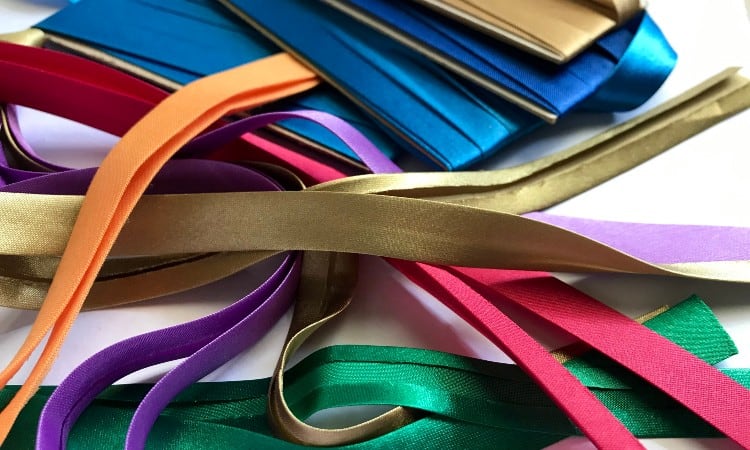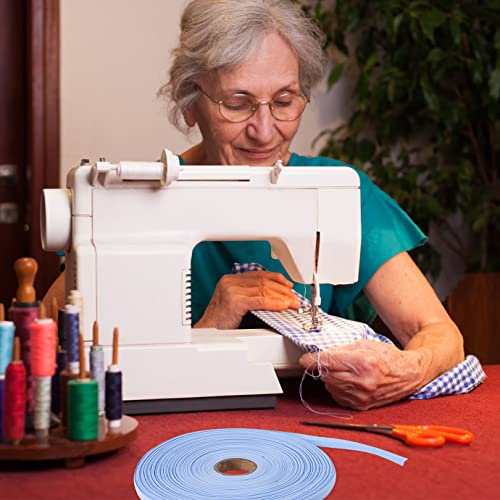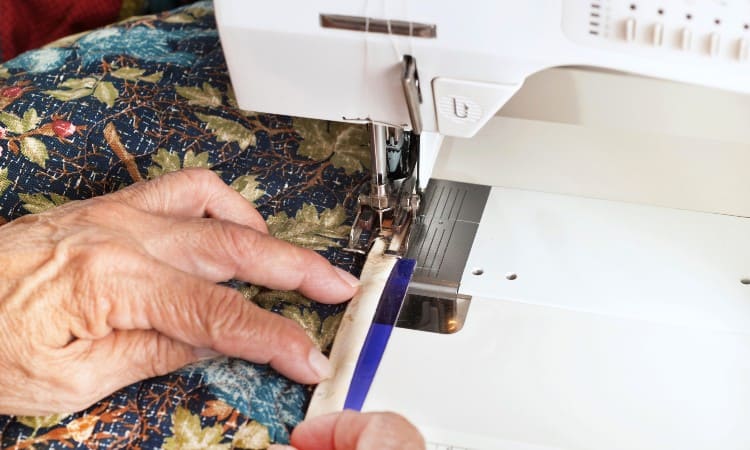If you enjoy sewing your own clothing, you’ve probably come across a pattern that asks you to use seam binding to finish your edges. What is seam binding? And more importantly, how can you tell you’ve found the right product for your project?
Seam binding, or specifically seam binding ribbon, is a flexible rayon strip used to clean up and seal raw edges on the fabric. However, the term “seam binding” is often misused in sewing patterns and instructions as a reference to any of the many products used to bind edges.
In this article, seam binding will be used to refer to seam binding ribbon. However, I’ll also explain the differences between seam binding and other common products like bias tape, twill tape, or hem tape. Also, I will explain the ins and outs of seam binding and what you should know to choose the right product for your next project.

Quick Navigation
- What is Seam Binding in Sewing?
- What Do You Use Seam Binding For?
- Common Products for Binding Seams
- How to Use Seam Binding
- What Is Straight Seam Binding?
- How Do You Sew Seam Binding Around Corners?
- Can You Finish Raw Edges of Fabric By Hand?
- Are Hem Tape and Seam Binding the Same Thing?
- Seam Binding vs Bias Tape
- Seam Binding Substitute
- Conclusion
What is Seam Binding in Sewing?
Seam binding is a product used to finish the raw edges of the fabric, improving its overall look and preventing the fabric from unraveling or fraying. This product is made of rayon and comes in the form of a narrow, flat ribbon that can be applied as-is or folded in half to encase the fabric’s edge.
Seam binding ribbon is usually sheer and will have subtle markings on its surface that act as a sewing guide for your stitches. It comes in many colors, which you can match to your fabric or choose a complementary accent color to give a bold finish.
You’ve probably encountered seam binding in your everyday life, especially if you wear suit jackets or other formal wear. Bridal gowns and other specialty items will also often use seam binding to give a more finished look to the inside of the garment.
What Do You Use Seam Binding For?
Seam binding ribbon has many uses, most of which center around improving the finished look of your sewing projects. This is because it covers raw edges, cut marks, or stitching, making a garment look unfinished.
The first use of seam binding is to seal raw edges of the fabric, which can help prevent fraying. Woven fabrics like cotton and linen are notorious for unraveling, and trapping their edges inside another fabric will help to keep them from moving and fraying over time. Seam binding can also prevent linings or similar products from appearing in your seams simply by hiding them behind a sheer ribbon.
Seam binding is also used to strengthen seams, and to keep them from pulling or separating during use. This is especially useful for areas of clothing that will see a lot of wear, such as the seams along your shoulders or in the inseam of pants. Applying a layer of seam binding ribbon will add reinforcement to keep these seams from wearing down over time.
The final use is to create clean-looking hems on garments. While hems can be achieved by simply folding over fabric and stitching it in place, this technique doesn’t always give an elegant look or finish. Instead, seam binding ribbon can be used to cover the edges of the hem, giving it a more refined look.
Common Products for Binding Seams
There are several different products available at your local craft store that can be used to cover the raw edges of fabric and give a distinct finish. Which you use will be determined by your personal preferences and the types of projects you sew.
Seam Binding Ribbon

Seam binding ribbon is a thin, narrow strip of fabric made from rayon. It will be sheer in appearance and will usually have markings on its surface to act as a guide for placing your stitches. It is flexible and moves well with the fabric, making it a good choice for use on clothing.
Seam binding ribbon is sheer and it may be possible to see the original fabric through the ribbon after you have sewn it. Matching the ribbon to the color of your fabric will help to make this less noticeable. However, this is worth noting if you plan to use a light-colored ribbon on top of a dark fabric.
Seam binding ribbon can shrink in the dryer, so you should always pre-wash and dry it before you sew. It should be ironed flat if that’s how you plan to apply it or folded in half and pressed if you plan to encase the edges of the fabric in the fold.
Bias Tape
 Bias tape is often confused for seam binding ribbon, even though it is a different product entirely. Bias tape is edging made from folded-over fabric with a very plain weave. Most store-bought bias tape is usually made from cotton, though it can be made at home with virtually any fabric.
Bias tape is often confused for seam binding ribbon, even though it is a different product entirely. Bias tape is edging made from folded-over fabric with a very plain weave. Most store-bought bias tape is usually made from cotton, though it can be made at home with virtually any fabric.
You will probably find two types of bias tape at your local craft store. The fabric of single-fold bias tape has been folded twice, and this product is best used on the interior of your garment. This is different from double-fold bias tape, which has fabric that is folded three times and is most commonly used to bind outer edges.
While the seam binding ribbon can be sewn flat on a garment, the folds of bias tape almost always mean that the raw edges of the fabric will be placed inside the tape. Bias tape will almost always be visible on the front and back of the fabric’s edge. This makes it a popular choice for projects like quilts, but it may not always work if you don’t want your binding to be visible outside of your clothing.
True bias tape will be cut ‘on the bias,’ meaning that it is cut at an angle to the grain of the fabric. This allows the tape to have some stretch, making it better to go around curves like the neck or arm holes of a blouse. You should always pre-shrink your cotton bias tape to prevent it from warping after you’ve added it to your garment.
Twill Tape
 Twill tape is another way of reinforcing seams and covering raw edges, but usually only on the interior of the fabric. It is a flat woven tape that has a distinct herringbone weave. It can be made of cotton, linen, polyester, or wool but is generally only available in a beige or cream color.
Twill tape is another way of reinforcing seams and covering raw edges, but usually only on the interior of the fabric. It is a flat woven tape that has a distinct herringbone weave. It can be made of cotton, linen, polyester, or wool but is generally only available in a beige or cream color.
Twill tape is applied flat to your garment, much in the same way that seam binding ribbon can be. It can be softer to the touch, which may make it more comfortable to use inside your clothing. Like the other binding products we’ve discussed, you should always wash and dry your twill tape before you sew with it to prevent unwanted shrinking.
How to Use Seam Binding

Seam binding ribbon is fairly easy to use once you’ve had a bit of practice with it. To begin, you’ll want to identify the edge or seam you want to cover and decide if you want the ribbon to lay flat or be folded in half. You’ll generally sew it flat when you want to cover a seam and will fold it in half when you want to encase a raw edge.
If you plan to fold the ribbon in half, you’ll want to press the fold in place with your iron. This will give you a crisp fold and help you place it evenly along the edge. If you plan to sew the ribbon flat, you should still press it with your iron to eliminate any wrinkles.
Flat Application
A seam binding ribbon is applied flat on garments when you want to cover the edges of a hem or cover a seam to reinforce it. To do this, you will want to position the ribbon exactly where you want to sew it and pin it in place. Keep the ribbon flat and smooth to avoid bunching along the seam or hem.
Then, you will want to stitch along both sides of the tape, all the way along the seam. Try to keep your stitches straight and even, and use the guide marks on the tape as a reference. You can do this with your sewing machine or by hand.
Note that a flat application will show your stitching on the front of the garment. You can make visible stitches less noticeable by matching your thread to the color of your fabric. Alternatively, you can hand stitch the ribbon using a slip stitch, which will not be visible on the front of your garment.
Folded Application
When folded, seam binding can be used to fully encase a seam and trap raw edges inside the binding. This is often used for hems that will be visible on the front of the fabric or to finish the raw edges of seams on the inside of a garment.
With this method, you will want to place the fold of the ribbon on the raw edge you wish to cover, with half of the ribbon on the front side of the fabric and half on the back. Then, you will stitch the ribbon in place along its inner edge. Be sure to keep the halves of your ribbon aligned so that your stitches go through both the front and back of the ribbon at the same time.
You’ll want to match your thread to the color of your ribbon to make it less noticeable. You can also add a line of stitching along the fold of the ribbon, but this isn’t a requirement.
What Is Straight Seam Binding?
Straight seam binding is a broad term for products like seam binding ribbon. It generally refers to a flat strip used to cover and bind the edges or seams of a fabric. This is not the same as bias tape, which is folded.
Straight seam binding comes in a wide variety of colors, as opposed to options like twill tape. This binding is sold in most craft stores, or in a pinch, you could substitute regular ribbon to give a flat finish.
How Do You Sew Seam Binding Around Corners?
The easiest way to sew seam binding around corners is to make a 45-degree angle with the fabric as you turn. To do this, you will want to sew your folded binding along the first edge until you reach the outer margin of the fabric. Don’t go past this edge, or you’ll have difficulty making the turn.
Once at the edge, open the fold and bring it down along the next edge you plan to sew on. This will be at a 90-degree angle to your original path and cause the excess fabric to bunch at the corner.
Take the excess fabric, and fold it at a 45-degree angle. Lay it flat in the corner, trying to make it as neat of a fold as possible. Your binding should now be at a complete 90-degree angle around the corner.
Sew along the new edge, being sure to backstitch at the beginning to keep the new stitches from unraveling. Continue along the edge until you encounter the next corner, where you will repeat this process.
Can You Finish Raw Edges of Fabric By Hand?
Yes, you can hand sew the raw edges of the fabric to give a nice finish. You could certainly hand sew a simple hem without any edge binding products. Or, you could use a seam binding ribbon to hand stitch along a raw edge.
Many seamstresses prefer to hand stitch seam binding using a slip stitch to prevent the stitches from being visible on the outside of the garment. Just be sure to use lots of pins to hold the seam binding in place as you work, and check the front of the garment regularly to ensure your stitches are even.
Are Hem Tape and Seam Binding the Same Thing?
While they are incredibly similar, hem tape and seam binding ribbon are not quite the same thing. Regular hem tape is flat like seam binding ribbon and comes in many colors, but it is usually made of polyester instead of rayon. Beyond this, however, hem tape and seam binding ribbon can be used in the same ways.
There are other hem tapes on the market you will want to look out for, however. Many hem tapes are iron-on or press-on, meaning they have adhesives that stick to fabric when heat is applied. These won’t function the same as seam binding and won’t be a good substitution for it.
Seam Binding vs Bias Tape
Seam binding is a thin ribbon that starts flat but can be folded in half to encase the edge of a fabric. It is made of rayon and is sheer, with guide marks along its length to help you place your stitches.
Bias tape is made of woven fabrics like cotton that are a bit more coarse and less flexible than seam binding. It is made by folding fabric over on itself two or three times and is always applied while folded. It is often used for outer seam edges that you want to be visible on the final project.
Seam Binding Substitute
Depending on what seam binding is being used for, there are several substitutes you could try. If you’re looking for a flat application, try products like hem tape, twill tape, or even ribbons or flat trims. Just make sure to pre-wash and dry any options that could shrink to ensure they lay evenly on your final garment.
If you’re looking for folded applications, bias tape is a good substitution. You can make your own bias tape from any fabrics you have on hand, and there are even handy tools available to help make your folds even as you work.
Conclusion
With all the different ways of describing seam binding and other products to clean up the edges of your fabric, it’s no surprise that many sewers get confused. After reading this article, you should be able to tell the difference between many of the common products on the market and should now be able to choose the right one for your next project. Happy sewing!